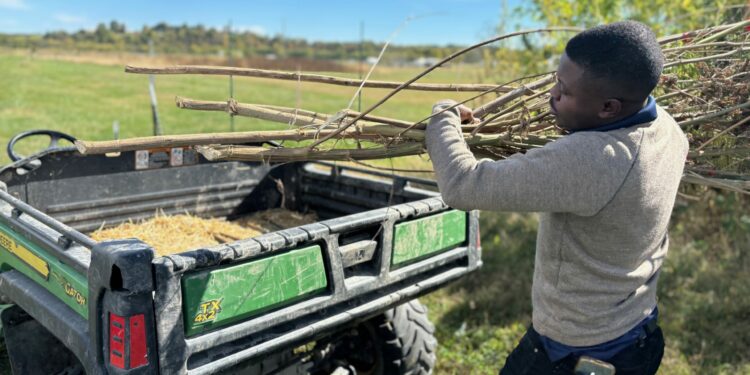JEFFERSON CITY, Mo. – On a bright chilly day in mid-October, Lincoln University graduate student Joshua Asiamah loaded tall, dried, brown stalks onto a John Deere all-terrain vehicle.
Asiamah moved from Ghana to the United States with an interest in studying legumes. But a different crop quickly caught his attention: hemp.
The 2018 Farm Bill contained a provision that reversed a longstanding ban on industrial hemp. Now Asiamah was one of the first to harvest a crop that had effectively been illegal since the 1930’s.
“I may be part of the forefront of people who are working on this hemp after it’s been opened from the ban that was on,” he said. “It’s being part of something big, something new.”
Lincoln University in Jefferson City, Missouri has received $5 million from the U.S. Department of Agriculture through the Partnerships for Climate-Smart Commodities program. Announced in 2022, the program is investing more than $3 billion in pilot projects that promise to support farmers who grow products with climate benefits. It’s part of the USDA’s broader goal of mitigating climate change through market-driven solutions in agriculture.
Researchers like Asiamah think hemp can be an important part of this approach. But for that to happen, growers will have to overcome the consequences of its lengthy prohibition, like a lack of seedstock that will grow well in the local climate, harvesting know-how and market challenges.
Why hemp?
Researchers suspected that hemp could be particularly good at carbon sequestration, or holding carbon in the soil and keeping it out of the atmosphere. Carbon dioxide is a greenhouse gas that traps heat radiating from the Earth and warms the planet, and agriculture contributes more than 10% of total greenhouse gas emissions in the U.S. Lowering that number is a goal of the Climate-Smart Commodities program.
“[Hemp does] tend to have deep roots in comparison to some of our other crops,” said Cody Bagnall, a research scientist at the Donald Danforth Plant Science Center in St. Louis, Mo., which is a partner on Lincoln’s project and works on improving the genetics of hemp roots. “The more root biomass you have, the more carbon gets stuck there.”
Babu Valliyodan, chair of Lincoln’s Hemp Institute, said preliminary research results have confirmed that hemp can put two to three tons of carbon into the soil per acre per year. For comparison, cotton, when using the best management practices, holds in an average 428 pounds per acre per year, according to a study from the USDA’s Agricultural Research Service.
Because of that, the researchers are also looking into hemp’s application as a rotational crop. Rotating crops is the practice of planting different plants on the same plot of land, rather than replanting the same one over and over. According to the USDA, rotating crops can lead to “increasing yields, improving nutrients and organic matter in the soil, and it can help disrupt the lifecycle of crop pests, reducing chemical use.”
Lincoln’s team is focused on growing three broad types of hemp: hemp that can be used for fiber, for grain (hemp seeds), and for both. These have a host of applications for consumer goods like textiles, livestock bedding, food for people, feed for animals and even construction. Valliyodan says they’re also converting hemp oil into a biofuel that can be used for heating and transportation.
In theory, all of these end products will be more sustainable and renewable.
“This is a unique crop that has a lot of potential to replace synthetic products with natural products, and that’s always good for the climate and, as a result, it’s good for the community,” Bagnall said. “You’re seeing a lot of stuff in the news about forever chemicals, about plastics, microplastics. The hemp products have none of that. At the end of the day, if it’s a T-shirt and you’re done with it, let it rot and go back to being the basic elements that it was before.”
Making up for lost time
The USDA is investing more than $3 billion in approximately 140 projects under the Partnerships for Climate-Smart Commodities program, including for crops like cotton, soybeans and rice. The individual projects are all different, but broadly focus on examining which management practices for a given commodity result in the widest climate benefits.
Ten projects focused on hemp received nearly $170 million in funding for work in states ranging from Wisconsin and Missouri, to Tennessee, Kentucky, Louisiana and Mississippi.
But hemp is complicated. Unlike many of the other crops being investigated, hemp doesn’t have solid preexisting genetics, growing practices or supply chains because it’s only been legal to grow since 2018.
It wasn’t always that way. Hemp was an important crop in early America. It was grown in the colonies and its fiber was used for textiles, clothing and more. Ships in the Revolutionary War used it for ropes and sails. The hemp industry thrived in the mid-1800s before substitutes like cotton became more popular.
In the 20th century, the United States saw intense propaganda against marijuana, a close cousin to hemp but with higher levels of a psychoactive component called delta-9-tetrahydrocannabinol, or THC, which can get people high.
As a result, the U.S. passed the 1937 Marihuana Tax Act, which imposed licensing and tax requirements on marijuana. It effectively banned all cannabis plants, which included both hemp and marijuana, from being sold or possessed.
In 1970, all cannabis was formally outlawed by the Controlled Substances Act.
All of the knowledge around how to grow hemp, the plants that were adapted to U.S. conditions, and even processing infrastructure disappeared.
“We destroyed everything during the ban,” Valliyodan said.
It wasn’t until 2018 that federal law finally drew a distinction between marijuana and hemp and legalized the latter.
“We’re left with kind of a blank slate when it comes to developing and designing a crop that does what we need it to do,” Bagnall said.
The upside of that is projects like Lincoln’s could pioneer a budding industry. But there’s a lot of work to do before hemp is viable in the ground and on the market.
The first step is developing genetics once again. Other countries have continued to grow hemp and markets for it. For example, even though it was banned in China between 1985 and 2010, A USDA Foreign Agriculture Service report valued the Chinese hemp market at $1.7 billion in 2017.
But crops from overseas aren’t optimized for growing in the U.S. So researchers on the project have to plant existing varieties, study their characteristics and breed plants together to find varieties suitable for local growers.
Source link : http://www.bing.com/news/apiclick.aspx?ref=FexRss&aid=&tid=67192db2544b405db390149995475550&url=https%3A%2F%2Farktimes.com%2Farkansas-blog%2F2024%2F10%2F23%2Ffor-decades-the-government-banned-hemp-now-its-funding-hemp-research-to-fight-climate-change&c=10113383778850725081&mkt=en-us
Author :
Publish date : 2024-10-23 05:28:00
Copyright for syndicated content belongs to the linked Source.


 100vw, 780px”/></p><p>“We’re working on that, to start to develop crop varieties that will grow real well here in Missouri,” said Christian Carson, a genetics researcher working in Lincoln’s hemp lab. “And it can be hit or miss. I’ve seen people plant and almost get nothing and I’ve seen other people plant and get a great crop.”</p><p>Researchers and farmers also have to figure out the best practices for growing hemp in Missouri. </p><p>Questions remain about optimal planting time, how deep seeds should be inserted into the ground, the best time to plow and how long plants should be left before harvest. </p><p>Joshua Asiamah and his team of fellow grad students at Lincoln visit the hemp fields daily to collect hemp and test it for a plethora of characteristics. </p><p>“We are leaving it on the field for some time, and then we test it to see, okay, at 14 days, what qualities does it have?” Asiamah said. “What cellulose does it have? What amount of lignin, which is important in the fabric industry, does it have?”</p><p>Processing Bottlenecks</p><p>Aside from difficulties with growing the plant itself, the industry’s ban nearly a century ago has led to bottlenecks in the supply chain, starting with a lack of standardized, specialized equipment to harvest hemp. Its fibrous nature causes combines used for crops like corn and beans to malfunction and that’s caused some fiery damages at Lincoln. </p><p>“It did happen to us a couple of times, the smoke started coming out because the fiber got entangled inside and the drum got stuck,” Valliyodan said. </p><p>Another big bottleneck is the processing of hemp, which is also specialized. </p><p>Midwest Natural Fiber is one of the only hemp processors in the region and a partner on Lincoln’s project. It’s tucked away in southeast Missouri, about 250 miles from the university. </p><p>It’s been in business for four years and CEO Patrick Van Meter said there’s still a lot of trial and error.</p><p>“To say that it’s 100% figured out is probably not accurate,” he said. </p><p>Currently, their process starts with dried, harvested bales of hemp, which are run through their equipment </p><p>“Everything we do here, if you want to sum it up, is just trying to separate the fiber, which is the outside of the plant, from the hurd, which is the woody core of the plant,” Van Meter said</p><p>Hemp hurd resembles wood chips, and Van Meter said it currently has much more demand than the fiber side. Hurd has applications for insulation, animal bedding and as substitutes for materials like wood and concrete.</p><p>The fiber resembles tangled scratchy strands of straw when it’s separated from the hurd, and Van Meter said it’s tougher to find buyers for it. That’s because there’s more processing that needs to happen before it can be turned into final products, like paper and textiles.</p><p>The lack of growth at the processing stage ties into the struggles of growing hemp. Without enough hemp being grown, processors can find it risky to start a business or scale up. And without a nearby processor to contract farmers for hemp, it can be costly to grow. </p><p>“There’s a lot of chicken and egg here,” Van Meter said.</p><p>A similar tension exists between processors like Midwest Natural Fiber and the next-step manufacturers who buy hemp hurd and fiber from them and turn it into products.</p><p>“There’s strong interest from the market side, from big brand name companies, but they’re not going to move too quick to position themselves to incorporate the product until they are certain that there’s a scalable, consistent, dependable supply behind it,” Van Meter said. </p><p>Van Meter said he’d even welcome competition from other processors, because success in the industry would help him expand, too.</p><p>Lincoln University, as part of its USDA grant, is trying to tackle all sides of the problem. </p><p>Valliyodan said his team should have a few varieties optimized for Missouri’s farmers in three to five years. </p><p>“If 30 farmers are coming up to grow this hemp, that means there’s a big success,” he said. “Their courage to come into a new market, that’s really appreciated.”</p><p>This story is a product of the Mississippi River Basin Ag & Water Desk, an independent reporting network based at the University of Missouri in partnership with Report for America, with major funding from the Walton Family Foundation. </p><p align=)







